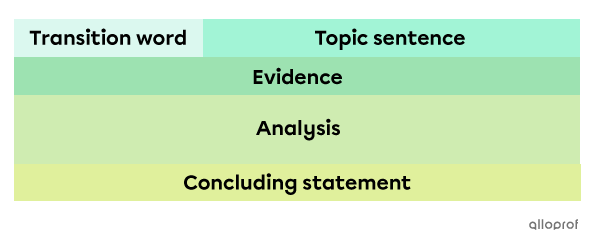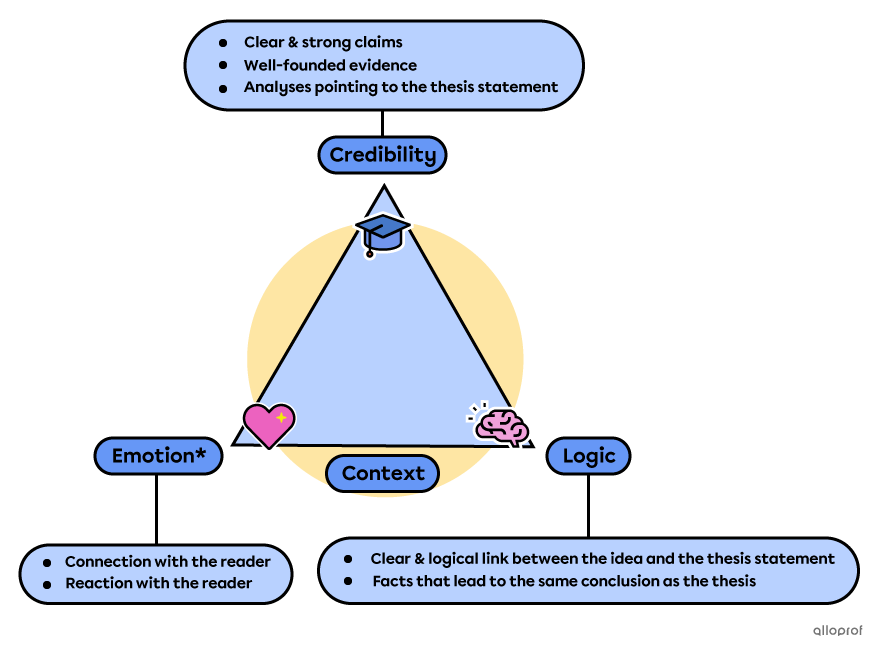Body paragraphs contain the text between the introduction and the conclusion. Each body paragraph contains an argument and pieces of evidence supporting the thesis statement. The number of body paragraphs varies.
In argumentative texts, a body paragraph should look like the following:

For an argument to be credible, the progression of ideas needs to be clear, coherent and logical.
Transition words or phrases are used to introduce a body paragraph.
Here are some examples:
|
First body paragraph |
Second body paragraph |
Third body paragraph |
|
First |
Second |
Third |
|
Firstly |
Secondly |
Thirdly |
|
To begin |
To continue |
Next |
Transition words are followed by a comma. Throughout the text, the transitional expressions used for a sequence need to be coherent.
A short and concise sentence that clearly states the main argument/claim of the paragraph. A good topic sentence is:
-
short
-
linked to the thesis statement
Information that supports an argument and strengthens the thesis statement. Good evidence:
-
is credible.
-
is relevant to the topic and thesis statement.
-
backs up the argument in the paragraph.
A paragraph can contain more than one piece of evidence. Each piece of evidence needs to be followed by an analysis (explanation).
When using information coming from external sources, writers must provide a reference. It will help readers determine the evidence’s credibility.
To avoid plagiarism (passing off someone else’s words as your own), referencing is mandatory whenever you are using information that isn’t yours.
Giving credit to the source of information enables readers to:
-
separate your writing from your source of information
-
find the source of your information
-
verify your information
-
evaluate your evidence’s credibility
There are many referencing methods and styles each including specific elements for a reader to track down an information source.
One easy way to reference the source is to mention where the information is from and who wrote/said it.
When your information comes from a website, you can reference the web address. For instance, if you used information from Alloprof’s website, referencing alloprof.qc.ca in your text would be enough.
You can add the reference:
-
directly inside the paraphrased text
-
next to the paraphrased or quoted text using parenthesis
To make sure the essay remains coherent, authors must stick with their chosen referencing style throughout the entire text.
Although both quoting and paraphrasing are good ways to include information, there is a major difference between the two techniques:
|
|
Quoting |
Paraphrasing |
|
Description |
Copying another person’s exact words. Quotation marks must be used and a reference must be included. |
Using different words to express someone else’s ideas. Quotation marks are not used, but referencing is necessary. |
|
Example |
As seen on alloprof.qc.ca, “Adopting a few routines may sound trivial, but you’d be surprised how much they can benefit your child and improve their experience at school.” |
As explained in Alloprof parents’ article “The benefits of a homework routine”, even if incorporating a homework routine in children’s lives may seem unimportant, it can actually enhance their overall schooling experience. |
Sentences explaining how the evidence relates to the thesis statement. A complete analysis:
-
is written in the author’s own words.
-
gives additional information about the evidence.
-
proves the quality of the evidence by explaining how it is relevant to the topic.
-
describes the consequences and/or implications of the evidence.
A sentence wrapping up the paragraph by rephrasing the main argument of the paragraph. A good concluding statement:
-
is concise.
-
summarizes the general idea of the paragraph and links it to the thesis statement.
-
concludes the idea presented in the paragraph with a smooth transition into the next paragraph.


There are many forms of evidence. Here are some examples:
|
Description |
Example |
|
Brief story about individual or personal experiences. |
A friend of mine recently told me he consulted Alloprof for a chemistry project. He is in his third year of university. This demonstrates Alloprof not only helps elementary and secondary students, but students at higher levels as well. |
|
Description |
Example |
|
Gathering several pieces of evidence. |
In addition to being a free resource for students, Alloprof.qc.ca offers online creative concept sheets and a 24/7 Help Zone where students can text or call teachers and get answers in less than 24 hours. Also, the website offers several interactive crash courses to practice for exams as well as interactive activities that make learning fun. |
|
Description |
Example |
|
Comparing similar and/or different information. |
In Quebec, Alloprof is the most consulted website by elementary school students during homework hours. According to their 2021-2022 annual report, Alloprof was consulted by 64% of students whereas Google was consulted by 29% of them. |
|
Description |
Example |
|
Giving meaning to a word/term. |
Alloprof also offers video crash courses. Cambridge University Press defines a crash course as a “course that teaches you a lot of basic facts in a very short time.” |
|
Description |
Example |
|
Giving details about something. |
When it was founded in 1996, Alloprof’s main goal was to decrease Quebec’s school dropout rates (alloprof.qc.ca). Since then, the non-profit organization has evolved exponentially to offer students a variety of academic resources to help them succeed. |
|
Description |
Example |
|
Listing examples or facts as evidence. |
Alloprof is free, accessible, dynamic and motivating. |
|
Description |
Example |
|
Giving readers concrete evidence. |
Alloprof provides students with a variety of ways to get help. For example, Alloprof offers a Help Zone which allows students to get an answer to their questions from a teacher in less than 24 hours (alloprof.qc.ca). |
|
Description |
Example |
|
Providing verified/proven information. |
When students ask a question in the Help Zone, Alloprof’s current artificial intelligence system will instantly suggest a link to a concept sheet or an interactive exercise. Shortly after, a real-life teacher makes sure that the student’s question was answered and gets in touch with him/her to provide further assistance. |
|
Description |
Example |
|
Using different words to express someone else’s ideas. |
Alloprof parents’ article “The Benefits of a Homework Routine’’ mentions that adopting a homework routine can be extremely beneficial for students for it helps them develop their consistency, perseverance and discipline. |
Quotation marks are needed for direct quotations.
|
Description |
Example |
|
Copying another person’s words. |
As mentioned in the article “The Benefits of a Homework Routine”, “Adopting a homework routine is a great way to make your child’s after-school work a priority. As well as being a good habit, it helps foster consistency, discipline, and perseverance.” (alloprof.qc.ca) |
|
Description |
Example |
|
Using different words to clarify something previously stated. |
Alloprof has a significant amount of educational interactions per year. In other words, Alloprof employees not only answer students’ questions, but also talk with parents, school boards, as well as current and future educators all around the province. |
|
Description |
Example |
|
Any fact, information or data provided by a research study. |
Studies show that students who use Alloprof develop three crucial factors impacting school perseverance and academic success. Indeed, according to Alloprof’s 2021-2022 annual report, when students use the platform’s services, their self-esteem, autonomy and motivation increase. |
|
Description |
Example |
|
Verified numerical support. |
Alloprof teachers have about “60 million educational interactions per year.” (alloprof.qc.ca) |
|
Description |
Example |
|
Graph, chart, image |
|
According to the context, writers can use three argumentative appeals to make solid arguments. An argumentative appeal is a persuasive strategy that writers can use to support and strengthen their arguments.
The three argumentative appeals are:
-
Appeal to credibility
-
Appeal to logic
-
Appeal to emotions*

*Appeal to emotion is appropriate when writing opinion and persuasive texts.
